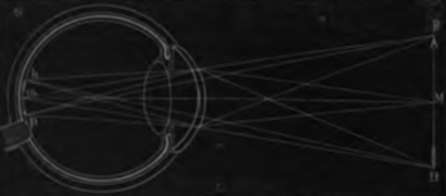Reversed Images
Description
This section is from the book "Wonders Of The Human Body", by Auguste Le Pileur. Also available from Amazon: Wonders of the Human Body.
Reversed Images
The eye may be compared to an optical instrument known as the camera obscura. It is well known that the image of objects appears reversed on the screen of the camera; in the same manner the luminous rays which spring from every point of an object at which we look, traverse the cornea, the aqueous humor, the crystalline, and the vitreous body, in order to reach the retina; and are refracted in this transit, so that the image which they form appears reversed at the bottom of the eye. In examining the eye of an ox, of which the sclerotic has been previously made thin—or the eyes of albinoes, such as white rabbits, for example, which are destitute of pigment, and in which the sclerotic and choroid are transparent, we may see, as Magendie pointed out, the flame of a candle reversed upon the retina.
How then are we able to see objects in their real position? Buffon and others have asserted that reason enables us to restore the image depicted on the retina to its real position, that touch enables us to rectify the visual sensation. But Cheselden, having by an operation enabled a patient born blind to see, does not state that the young man first saw objects otherwise than in their real position; and the careful observations made by this skilful surgeon do not permit us to suppose that a circumstance of such importance could escape his notice. According to M. Lame, we know that objects are upright although we see them inverted, from the consciousness of the movements which we give to the optical axes of our eyes in looking successively at the different points of objects from top to bottom.

Fig. 37. Course of the luminous rays in the eye.
H, M, P. Luminous rays emanating from an object. h, m, p, Luminous rays refracted, forming the inverted image on the retina.
Muller avers that we see the objects inverted, but that a presenting themselves to us under the same relative conditions of position, nothing can appear inverted because we see everything in the same position, and that our notions of uprightness or inversion only exist by opposition.
M. Longet explains upright vision by supposing that every external luminous point is felt in the eye according to the direction it takes relative to us. We must, says this eminent physiologist, consider the concave spherical surface of the retina as formed of a mosaic, each elementary part of which is a sort of eye designed to perceive the different luminous impressions in a determinate direction. Every pencil of light emanating from a luminous point, and forming a cone of which the apex and the normal axis correspond to one of these portions, will be perceived in the direction of a line joining the centre of the spherical surface to the object looked at If we reason in this way for every one of the points which constitute the whole of a visible object, the perception of each of these points will be in the real direction, and that of the whole will also be felt under the same conditions, in regard to the observer. The image therefore is not seen as a complete whole; each luminous point assisting in its formation making a separate impression on the brain, each one is felt according to the primitive direction of the ray of light, and the whole is seen in its real position.
Continue to:
